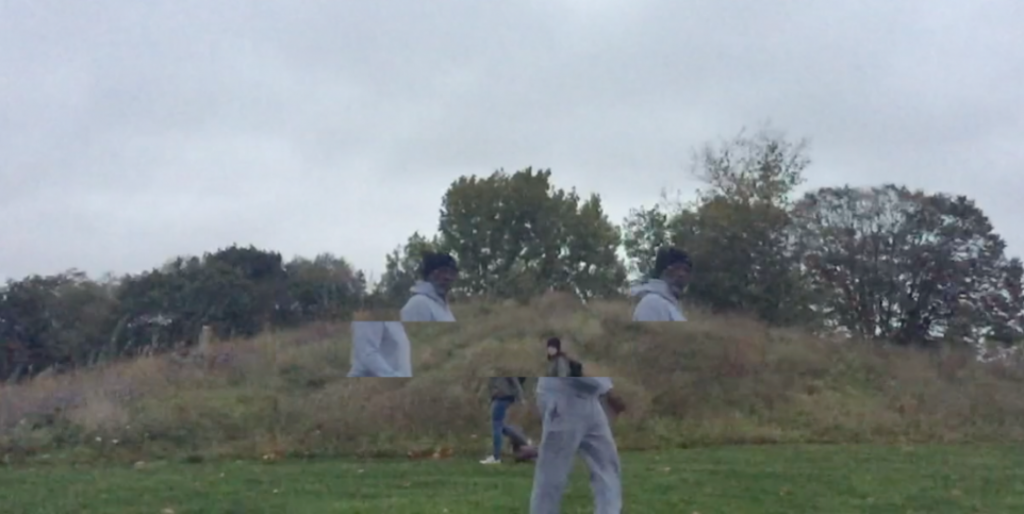Recently I’ve been reading more than looking at art works themselves, something that I’m aware of and will try to balance more successfully next term.
TRACEY ROSE – TKO
This piece comprises of a six-minute recording of the naked artist striking a punching bag with a camera attached to it with increasing force, slowing the footage down in certain parts before speeding it up again when impact occured. The physicality of the work was modulated by its subsequent projection onto a transparent scrim, which rippled and crumpled as if being physically affected by what was being projected onto it: a punching bag for the image.

(1)
According to ArtThrob.co.nz, “Recently, Rose’s work has become more abstract. The piece Rose refers to as “my masterpiece” is TKO (2000), which had its roots when Rose took up boxing and trained at a downtown Johannesburg gym for an extended period “because I wanted to beat up a curator who I thought put up an extremely crap show – I decided not to participate” Invited in 2000 to take up a residency at the prestigious ArtPace Institute in San Antonio, Texas, Rose proposed the piece which became TKO, in which the artist, unclothed, boxes a punching bag in an ever increasing crescendo of blows and cries, under the surveillance of four spy cameras, including one in the punching bag itself . “Monet’s waterlilies struck me – that commitment to the surface – my understanding of boxing was that it was an art, a passion, like dancing, and the intention was that each punch would be a mark, a gesture, building up to something”. The images are pale and shifting, the sounds urgent and guttural, and the artist/protagonist is both victim and aggressor, implicating the viewer in this complex visceral exchange.” (1)
RICHARD PRINCE – COWBOYS
I am not a fan of Richard Prince at all. He’s extremely problematic and I don’t believe that any his recent work does much to redeem himself as a white male artist with a considerable amount of power. However, I did find his 1989 piece Cowboys fairly interesting, in the sense of a male dominating a landscape in the name of advertising.
 (2)
(2)
It reminded me of the tourism leaflets with the figure gazing across the Grand Canyon/New York City/A Norwegian Glacier etc. that were talked about in Nick Kaye’s book on Site Specificity and Performance, which of course hark back to those romantic paintings of male figures standing over a sprawling landscape, displaying Caspar david Friedrich’s idea of the landscape being something to be both coveted and feared. I recently photoshopped the protagonist out of Der Wanderer über dem Nebelmeer (as a pastiche of Paul Pfieffer), but I’m not sure if I’ll do anything with it.
PAUL PFEIFFER
The Pfeiffer work that I was recommended was The Four Horsemen of the Apocalypse Series, where the artist selected imagery from the NBA’s archive and ‘camouflaged’ critical contextual details of the scene, such as the basketball, players’ vest graphics, and even background players, leaving behind these eerie images of solitary figures lunging at nothing, followed by the wide eyes of a baying crowd.
These works were a follow up to an earlier series of work by the artist entitled 24 Landscapes, which at first do seem like ordinary seascapes, until you start to notice a sourceless shadow, or a set of tracks leading to the centre of the image before halting. These used to be images of Marilyn Monroe, but Pfeiffer edited her out of them, shifting the focus completely without giving the audience a choice. This process of digitally ‘camouflaging’ is very interesting, and something I’d like to explore myself.
SHOWS (Painting)
Lynette Yiadom-Boakye/Cecily Brown @ ‘All Too Human’, Tate Britain


Michael Armitage @ SLG






Kaye Donachie @ Maureen Paley



(1) https://artthrob.co.za/01mar/artbio.html
(2) https://www.guggenheim.org/arts-curriculum/topic/cowboys
All other photos my own
